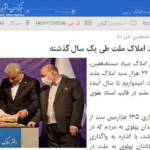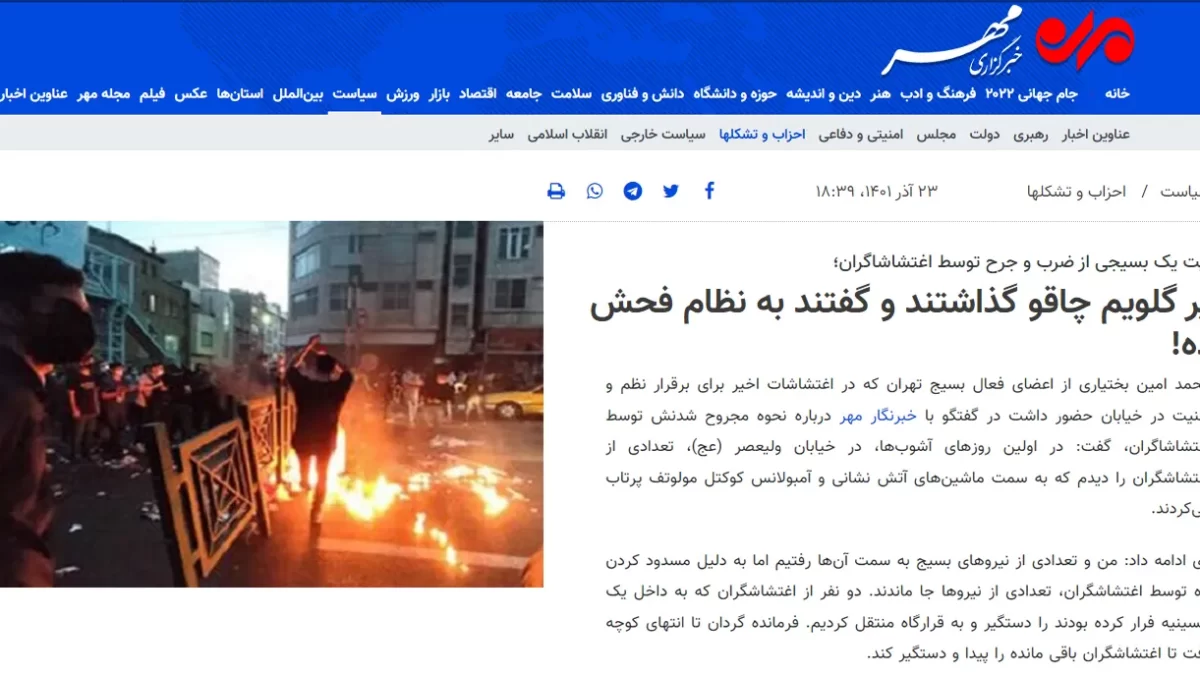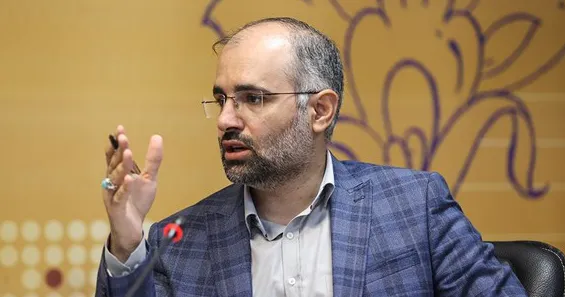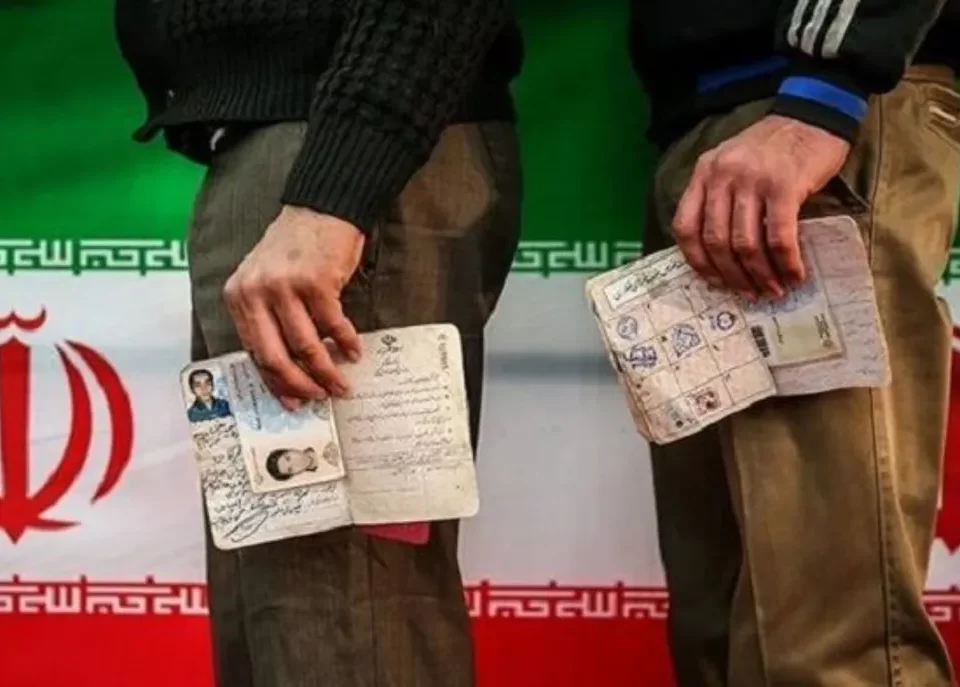
Media Review: Propaganda of the Destitute Foundation with Fake Advertising and Property Transfers to the People
May 7, 2023
Media Review: Fars News Agency and the Conspiracy Theory of Paris Gathering
May 7, 2023Media outlets, journalists, and writers often employ the tactic of storytelling to convey complex personal experiences in a way that allows the audience to better understand and visualize the narrative, as well as grasp its finer details.
Storytelling, in addition to its personal benefits for the narrator and the listener, serves a communal understanding when repeated within a society. It fosters a sense of collective empathy and can lead to “social changes” because storytelling opens a new window for us to realize that life is not merely what we believe it to be.
When professional media outlets use storytelling techniques to narrate an event, they usually present the characters of the story as heroes, villains, victims, or saviors. These characters have the ability to capture the audience’s attention and create a sense of empathy with the audience.
However, when the propaganda machine utilizes storytelling tactics to manipulate public opinion, not only does the story and its narrative fail to have a positive impact on society, but it also undermines public trust in the narrating media and the ideological current benefiting from the story.
To shed light on the issue, let us examine this report published by the Mehr News Agency on Azar 23, 1401 (December 14, 2022) titled “They Held a Knife to My Throat and Told Me to Insult the System!” The report presents an account attributed to a Basiji member named “Mohammad Amin Bakhtiari.”
The Mehr News Agency has narrated the story of this Basij member as follows: “In the early days of the turmoil, on Vali Asr Street, I saw a group of rioters throwing Molotov cocktails at fire trucks and ambulances. Some of the Basij forces and I went towards them, but due to the blockage of the road by the rioters, some of the forces were left behind. We apprehended two of the rioters who had fled into a Hussainiya (Shia religious gathering place) and transferred them to the base. The commander of the unit went to the end of the street to find and apprehend the remaining rioters. I waited alone in the alley for the commander of the unit to return. At that moment, several rioters who had hidden inside houses attacked me from behind. They grabbed my hands and feet, beat me with sticks, and used vulgar language. One of the rioters started filming with a phone, and another one put a knife under my throat, demanding that I insult the system with vulgarities. In that moment, my gaze fell on the flag of Ya Hussein (a religious flag). I entrusted myself to Imam Hussein, closed my eyes, and remained silent. Later, the commander of the unit ran towards us from the end of the street, which led to the rioters fleeing. Some of the Basij forces took me on a motorcycle close to the security forces to transfer me to the hospital. When I reached the security forces, several people started throwing stones. At that moment, I lost consciousness, and my friends told me the rest of the story. The children of the security forces shielded me with their shields so that the stones wouldn’t hit me, and a few minutes later, they transferred me to the hospital. In the hospital, when a few people realized that I had been attacked by the rioters, they also started beating me, and we were forced to leave the hospital and transfer me to another hospital. The rioters used equipment such as batons and tasers, and due to the blows I had received, several parts of my body were injured. In addition to my leg, my jaw and some of my teeth were also broken. One month after this incident, I attended gatherings with a broken leg and a cane, and some people threw objects at us, causing further injuries.”
Why is this narrative fake and propaganda?
Mehr News Agency has titled this story as the narrative of an active Basij member named Mohammad Amin Bakhtiari, but is this Basij member well-known? Has he provided any credible evidence to support his claims? Have any photos or videos of this individual and the incidents that happened to him been published? Is Mehr News Agency impartial in its storytelling and an independent and unbiased media outlet?
The answer to all these questions is “no.” Therefore, when there is no evidence to support these claims, why should the audience trust and believe such a narrative? The author has not even put in the slightest effort to make the story credible or address the question of why the audience should accept this story. The only thing they have done is choose the name of the Basij member as Mohammad Amin, perhaps for symbolic effect.
Rather than being a journalistic art form used to facilitate the audience’s connection with the depth of the real story and its details, this report is an example of propaganda with the tactic of “attacking opponents.”
Attacking opponents is one of the well-known tactics of propaganda. In this tactic, media and advertising activists try to undermine the legitimacy, credibility, accuracy, and character of opponents and question their beliefs.
The goal of creating conflicts and polarization in society in this tactic is to suppress and censor complex ideas and information and prevent independent media from uncovering the truth. In other words, the propaganda apparatus, by attacking opponents and presenting deviant ideas, tries to distract the general public’s attention from the essence of the matter and confuse their minds so that the truth remains hidden, exactly like what can be seen in Mehr News Agency’s report.
The virtual space is full of fictional stories with imaginary characters that are presented to the audience by users as real narratives.
Audiences who have critical thinking and are seeking the truth usually turn to professional and unbiased media to evaluate the accuracy of these narratives, to see if they have been reflected in reputable media or not. Because reputable and well-known media outlets are good for evaluating and assessing the validity and accuracy of any claim. But when professional media themselves engage in storytelling that the audience cannot believe, it means that the audience is facing a confused media environment, so they are forced to turn to sources other than internal and government-friendly sources.
Media and journalists are decision-makers in the process of selecting and covering news and information. They decide what story and what part of the story to tell among a mass of information. In this process, there is a professional rule, and that is that media outlets pay special attention, firstly, to credible sources. They tell a story that stems from a credible source and, secondly, strive to gain the trust of the audience by adhering to the principle of fair, balanced, and impartial information coverage. In other words, when a narrative and story have different aspects and sides, they try to give all voices a fair chance to express themselves in order to maintain their impartiality.
Imagine you have a criminal defense lawyer; when he first meets his client in the detention center or outside the prison and hears from him that he has been subjected to torture, he does not immediately take action to file a complaint against the torturer or immediately bring it up in court. Instead, he first tries to find solid and court-friendly evidence to prove the torture. Journalists are in a similar position and cannot consider a person’s narrative accurate and true based solely on their claim. Instead, they try to eliminate ambiguities and obtain minimal trust in the claim’s accuracy by examining the documents and evidence presented. Then, through conversations with other stakeholders, witnesses, and parties involved in the story, they prepare a narrative that can be presented for publication.
When a journalist narrates a story, especially from an anonymous or lesser-known individual, without conducting proper investigations, it is necessary to doubt its accuracy and evaluate it as potentially fake reports.
This is because the goal of propaganda is to manipulate public opinion and guide people’s beliefs. By attacking opponents, playing with emotions, simplifying information, and catering to the needs of the audience, propagandists seek to control and dominate the intellectual space of society. Having a critical mindset and rejecting any unfounded claims is the way to counter government media and their fabricated narratives.
مرور رسانهها؛ خبرگزاری مهر و داستان جعلی یک بسیجی
معمولا رسانهها، روزنامهنگاران و نویسندگان از تاکتیک «قصهگویی» یا «Storytelling» برای بیان تجربههای پیچیده فردی استفاده میکنند تا مخاطب بهتر و راحتتر بتواند ماجرا را در ذهن خود تجسم و جزییات بیشتری از آن را درک کند.
داستانگویی علاوه بر منافع شخصی که برای گوینده و شنونده دارد، زمانی که در سطح جامعه تکرار میشود، به درک مشترک میان اعضای جامعه میانجامد و یک همدلی عمومی ایجاد میکند و میتواند مسبب «تغییرات اجتماعی» نیز باشد؛ چرا که داستانگویی پنجره جدیدی به روی ما باز میکند تا دریابیم زندگی تنها آن چیزی نیست که ما به آن باور داریم.
رسانههای حرفهای وقتی از فن داستانگویی برای بیان یک رویداد استفاده میکنند، معمولا شخصیت داستان آنها یک قهرمان، یک شرور، یک قربانی و یا یک ناجی است، زیرا این شخصیتها قادرند توجه مخاطب را جلب و یک همدلی را با مخاطب ایجاد کنند.
اما وقتی دستگاه پروپاگاندا از تاکتیک قصهگویی برای دستکاری افکار عمومی استفاده میکند، نه تنها داستان و روایت آنها نمیتواند بر جامعه اثر مثبت بگذارد بلکه اعتماد عمومی را نسبت به رسانه راوی و جریان فکری منتفع از داستان را تخریب میکند.
برای روشن شدن مساله، به این گزارش خبرگزاری «مهر» که روز ۲۳ آذر ۱۴۰۱ با عنوان «زیر گلویم چاقو گذاشتند و گفتند به نظام فحش بده!» منتشر کرد، توجه کنید؛ روایتی به نقل از یک بسیجی به نام «محمدامین بختیاری».
خبرگزاری مهر داستان این بسیجی را این گونه روایت کرده است: «در اولین روزهای آشوبها، در خیابان ولیعصر، تعدادی از اغتشاشگران را دیدم که به سمت ماشینهای آتش نشانی و آمبولانس کوکتل مولوتف پرتاب میکردند. من و تعدادی از نیروهای بسیج به سمت آنها رفتیم اما به دلیل مسدود کردن راه توسط اغتشاشگران، تعدادی از نیروها جا ماندند. دو نفر از اغتشاشگران که به داخل یک حسینیه فرار کرده بودند را دستگیر و به قرارگاه منتقل کردیم. فرمانده گردان تا انتهای کوچه رفت تا اغتشاشگران باقی مانده را پیدا و دستگیر کند.من در کوچه تنها منتظر ماندم تا فرمانده گردان برگردد. در همین لحظه چند نفر از اغتشاشگران که داخل خانهها مخفی شده بودند، از پشت سر به من حمله کردند. آنها دستها و پاهای من را گرفتند، با چوب کتک زدند و الفاظ رکیک به کار میبردند. یکی از اغتشاشگران با گوشی شروع به فیلمبرداری کرد و یکی دیگر از آنها با قرار دادن چاقو در زیر گلوی من خواست که به نظام فحشهای رکیک بدهم. در همین لحظه نگاهم به پرچم یاحسین افتاد. به امام حسین توکل کردم و چشمانم را بستم و سکوت کردم. بعد فرمانده گردان از انتهای کوچه به سمت ما دوید که منجر به فرار اغتشاشگران شد. تعدادی از نیروهای بسیج من را با موتور به نزدیکی نیروهای انتظامی بردند تا به بیمارستان منتقل کنند. زمانی که به نیروهای انتظامی رسیدم، چند نفر شروع به پرتاب سنگ کردند. در همین لحظه بیهوش شدم و ادامه داستان را دوستان برای من تعریف کردند. بچههای نیروهای انتظامی سپرهای خود را روبهروی من گرفتند تا سنگ به من برخورد نکند و چند دقیقه بعد من را به بیمارستان منتقل کردند. در بیمارستان چند نفر که از اغتشاشگران بودند، وقتی متوجه ماجرا شدند، آنها هم شروع به کتک زدن کردند و ما مجبور به ترک بیمارستان شدیم و به بیمارستان دیگری منتقل شدم. اغتشاشگران از تجهیزاتی مانند باتون و شوکر استفاده میکردند و به دلیل ضرباتی که به من وارد شده بود، چند نقطه از بدنم دچار آسیب شد. علاوه بر پا، فک و تعدادی از دندانهایم نیز شکست. یک ماه بعد از این ماجرا، من با عصا و پای شکسته در تجمعات حاضر شدم و عدهای به سمت ما وسایلی پرتاب میکردند که به من در آنجا هم آسیب وارد شد.»
چرا این روایت، جعلی و پروپاگاندا است؟
خبرگزاری مهر این داستان را روایت یک بسیجی فعال تهران به نام محمد امین بختیاری عنوان کرده ولی آیا این بسیجی، شناخته شده است؟ آیا او هیچ سند قابل قبولی برای صحت ادعاهای خود ارایه کرده است؟ آیا هیچ عکس یا فیلمی از این فرد و اتفاقاتی که بر او رفته، منتشر شده است؟ آیا خبرگزاری مهر بیطرفانه داستان را روایت کرده و رسانهای مستقل و بیطرف است؟
جواب همه این پرسشها، «خیر» است. بنابراین وقتی هیچ ادلهای برای صحت این اظهارات وجود ندارد. مخاطب چرا باید به چنین روایتی اعتماد و آن را باور کند؟ نویسنده حتی برای باورپذیری داستان، هیچ نبوغ و خلاقیتی به خرج نداده و حتی به خود کمترین زحمتی نداده است که به این سوال پاسخ دهد که مخاطب چرا این داستان را باید بپذیرد؟ تنها نام فرد بسیجی را محمد امین انتخاب کرده است تا شاید تاثیر سمبلیک داشته باشد.
این گزارش بیش از آن که هنر روزنامهنگار برای استفاده از فن قصهگویی برای تسهیل ارتباط مخاطب با عمق داستان و جزییات رویدادی واقعی باشد، یک مصداق پروپاگاندا با تاکتیک «حمله به مخالفان» است.
حمله به مخالفان یکی از تاکتیکهای شناخته شده پروپاگاندا است. در این تاکتیک، فعالان رسانهای و تبلیغی میکوشند مشروعیت، اعتبار، دقت و شخصیت مخالفان را زائل کنند و عقاید آنها را زیر سوال ببرند.
در این تاکتیک، هدف از ایجاد درگیری و دوقطبیسازی جامعه، سرکوب و سانسور ایدهها و اطلاعات پیچیدهتر و جلوگیری از ورود رسانههای مستقل به کشف حقیقت است؛ یعنی دستگاه پروپاگاندا با حمله به مخالفان و طرح ایده انحرافی، میکوشد حواس عموم را از پرداختن به اصل ماجرا منحرف و ذهن آنها را درگیر و مشوش سازند تا حقیقت پنهان بماند؛ دقیقا شبیه آنچه در گزارش خبرگزاری مهر میتوان مشاهده کرد.
فضای مجازی پر است از داستانهای تخیلی با شخصیتهای خیالی که توسط کاربران به عنوان روایتهای حقیقی به مخاطب عرضه میشوند.
مخاطبانی که تفکر انتقادی دارند و در پی حقیقت هستند، معمولا برای ارزیابی صحت این روایتها، به رسانههای حرفهای و بیطرف مراجعه میکنند تا ببینند آیا این روایتها در رسانههای معتبر نیز بازتاب یافتهاند یا خیر. چراکه رسانههای معتبر و خوشنام متر خوبی برای ارزیابی و سنجش درستی و صحت هر ادعایی هستند. اما وقتی رسانههای حرفهای خود به داستانپردازیهایی روی میآورند که مخاطب نمیتواند آنها را باور کند، یعنی مخاطب با یک فضای رسانهای مشوش روبهرو است، پس ناچار است به منابعی غیر از منابع داخلی و نزدیک به حکومت مراجعه کند.
رسانهها و روزنامهنگاران در پروسه انتخاب و پوشش اخبار و اطلاعات، تصمیمگیر هستند؛ یعنی از میان انبوه اطلاعات، تصمیم میگیرند چه داستانی و چه بخشی از داستان را روایت کنند. در این پروسه، یک قاعده حرفهای وجود دارد و آن این است که رسانهها اولا توجه ویژه به منابع معتبر دارند، یعنی داستانی را روایت میکنند که از یک منبع معتبر نشات گرفته است و دوما میکوشند با رعایت اصل پوشش عادلانه، متعادل و متوازن اطلاعات، اعتماد مخاطب را جلب کنند. به این معنا که وقتی روایت و داستان جنبهها و طرفهای متفاوت دارد، میکوشند به همه صداها، به طور عادلانه فرصت بیان دهند تا بیطرفی خود را حفظ کنند.
شما یک وکیل دادگستری را در نظر بگیرید؛ او در اولین ملاقات با موکل خود در بازداشتگاه یا خارج از محیط زندان، وقتی از او میشنود که مورد شکنجه واقع شده است، بلافاصله نسبت به شکایت از شکنجهگر اقدام نمیکند یا فوری آن را در دادگاه نقل نمیکند بلکه اول میکوشد ادلههای محکمهپسند برای اثبات شکنجه پیدا کند. روزنامهنگار هم درست در چنین موقعیتی است و به صرف ادعای یک فرد، نمیتواند روایت او را دقیق و عین حقیقت بداند و آن را منتشر کند بلکه میکوشد با بررسی اسناد و شواهدی که مدعی ارایه میکند، اول ابهامها را برطرف کرده و به حداقلی از اعتماد نسبت به صحت ادعا دست یابد، بعد با گفتوگو با سایر ذینفعان، شاهدان و طرفهای داستان، روایتی قابل ارایه برای انتشار تهیه کند.
وقتی روزنامهنگار بدون انجام این تحقیقات، یک روایت، آن هم از سوی یک فرد ناشناس یا کمتر شناخته شده را روایت میکند، باید نسبت به درستی آن تردید و آن را در ردیف گزارشهای جعلی ارزیابی کند.
این در حالی است که هدف پروپاگاندا، دستکاری افکار عمومی و جهتدهی به باور مردم است. آنها با حمله به مخالفان، بازی با احساسات، ساده کردن اطلاعات و پاسخ به نیاز مخاطبان میکوشند فضای فکری جامعه را کنترل و در تصرف خود داشته باشند. داشتن تفکر انتقادی و نپذیرفتن هر ادعایی، راه مقابله با رسانههای حکومتی و روایتهای جعلی آنها است.




